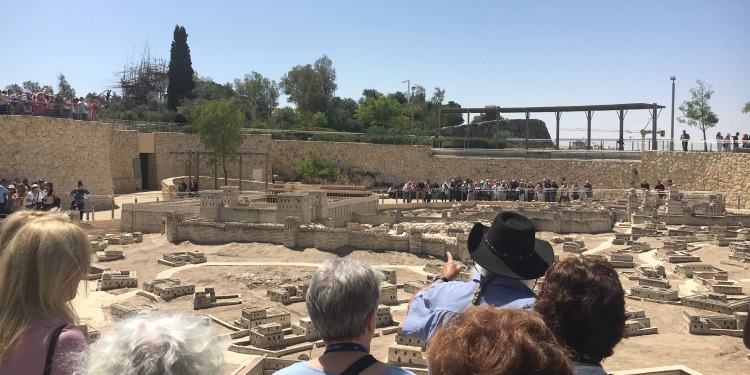Jerusalem as It Was
The Fellowship | May 15, 2018

As The Fellowship‘s tour of Israel continues, we share another story brought to you by our Chicago office writer who is on the tour!
After our tour group left Yad Vashem, our guide took us to the Israel Museum in Jerusalem to see an amazing, 1:50 scale model of the Holy City, depicted as it was in Jesus’ time.
But first a bit about our guide. Reuven is a Jewish man born in Singapore and raised in Australia. His bushy white beard and outback-style hat show you right away that he’s a man with many stories to tell. After making aliyah (immigrating to Israel) in 1970, Reuven worked on a kibbutz, served in the Israeli military during the Yom Kippur War, served for many more decades in the IDF reserves, and taught. As our group stood before this model of Jerusalem, Reuven put both his knack for teaching and his love for Israel to work.
Reuven told us that the outer wall that exists today around Jerusalem’s Old City is a relatively new wall, and that it was the city inside that was built by those names we know so well from the Bible: David, and Solomon, and Herod the Great. The model of the city, and Reuven’s deft telling of Jerusalem’s history, would bring the places and names to life when we saw the real thing in the coming days.
The model of the city – which allowed us to see from a birds-eye view where things were located and how they interacted with one another – brought the Bible alive. Reuven pointed out that the “haves,” such as King David, lived much higher on the hills than the “have nots,” which illustrates how the Israelite ruler was able to spot Bathsheba. Reuven focused especially on the location of the Temple – how people entered the city walls to worship, where the portico stood, and other logistical facts that seemed obvious once we could envision them.
The stories of the Israelites and their history were no longer just words on the printed page. We could see them, which is the whole point of our visiting the Holy Land – to let us see the Bible and its stories where they occurred.
Reuven returned to Herod the Great again and again over the coming days, as it was Herod’s work on the Second Temple – built after the Jewish people’s return from the Babylonian exile – and the Holy City that would transform the Jerusalem of Jesus’ time. And it was a moment from Jesus’ time that really brought Jerusalem to life for me.
On the model, Reuven pointed to a spot outside the Old City’s walls, outside the Sheep Gate. At that spot lay the pools of Bethesda, where people came to be healed. As we read in John’s Gospel, Jesus came upon a lame man there who had not been healed in the waters. But upon the words of Jesus, the man rose up, took up his mat, and walked.
Later that day – it was the Sabbath – the man found himself on the Temple Mount, within the city walls. There he told the Pharisees of the miracle, a miracle Jesus performed despite the law of not working on the Sabbath. And then the healed man pointed out his healer – Jesus – there within the city.
Why did this touch me so? Reuven pointed out there on the model of Jerusalem that the only way Jesus could have entered the city from Bethesda was on a paved path to the Sheep Gate. This path still lays outside the city today. So, Reuven told us, this is a spot where Jesus surely did walk, and that we could also walk, following in his footsteps … in the footsteps of the Bible.
In the days ahead, Reuven, our storyteller, teacher, and friend, would lead us over many more paths. Along the way, he helped truly make these biblical stories and figures even more real to us, helping us see them with our eyes, and feel them in our souls.
Read the other posts about the tour, including visits to Yad Vashem and Yad LaKashish.
